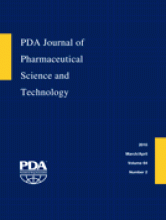Abstract
The pharmacopoeias list a number of microorganisms to be used in the compendial microbiological tests for confirming the growth-promoting, indicative, and inhibitory properties of the media and demonstrating the suitability of the test for a specific test article. Major national culture collections are specified as the sources for these test strains based on their history of deposition and maintenance and use in the compendial tests. Using these microorganisms, it has long been assumed that these strains are interchangeable and that sourcing the strains from different culture collections has no impact on the result of the media quality control and method qualification tests. In order to evaluate whether this assumption is correct and to add more certainty to the procedures, we investigated whether there are detectable differences among isolates of the same strain sourced from different culture collections. Using various phenotypic and genotypic identification and strain typing methods, nine major pharmacopoeial species were analyzed. As expected, most of the species showed very uniform patterns across the isolates, indicating that the strains were indeed identical. Surprisingly, the strains of Salmonella enterica subsp. enterica serotype abony showed distinct differences at both the genotypic and the phenotypic level, suggesting that the strains sourced from the different culture collections were not identical strains, or that they have undergone detectable genetic shift from the time they were derived from the original depositor. Irrespective of the level of genotypic or phenotypic homology identified here, there are no practical consequences on their performance in compendial assays. It is concluded that the compendial strains investigated in this study are indeed equivalent and will perform identically in compendial tests, making it safe to base pharmaceutical quality control procedures on the strains sourced from any of the recognized national culture collections.
- Microbial identification
- Quality control
- Strain typing
- Pharmacopoeia
- MALDI-TOF mass spectrometry
- Rep-PCR
- Ribotyping
- 16S rRNA gene sequencing
- Serotyping
- © PDA, Inc. 2010
PDA members receive access to all articles published in the current year and previous volume year. Institutional subscribers received access to all content. Log in below to receive access to this article if you are either of these.
If you are neither or you are a PDA member trying to access an article outside of your membership license, then you must purchase access to this article (below). If you do not have a username or password for JPST, you will be required to create an account prior to purchasing.
Full issue PDFs are for PDA members only.
Note to pda.org users
The PDA and PDA bookstore websites (www.pda.org and www.pda.org/bookstore) are separate websites from the PDA JPST website. When you first join PDA, your initial UserID and Password are sent to HighWirePress to create your PDA JPST account. Subsequent UserrID and Password changes required at the PDA websites will not pass on to PDA JPST and vice versa. If you forget your PDA JPST UserID and/or Password, you can request help to retrieve UserID and reset Password below.






